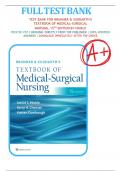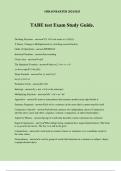Exam (elaborations)
Test Bank for Brunner and Suddarths Textbook of Medical-Surgical Nursing, 15th Edition by Hinkle, 2022 All Chapters 1-68 UPDATED
Test Bank for Brunner and Suddarths Textbook of Medical-Surgical Nursing, 15th Edition by Hinkle, 2022 All Chapters 1-68 UPDATED
[Show more]





